Related Research Articles

Amy Sillman is a New York-based visual artist, known for process-based paintings that move between abstraction and figuration, and engage nontraditional media including animation, zines and installation. Her work draws upon art historical tropes, particularly postwar American gestural painting, as both influences and foils; she engages feminist critiques of the discourses of mastery, genius and power in order to introduce qualities such as humor, awkwardness, self-deprecation, affect and doubt into her practice. Profiles in The New York Times, ARTnews, Frieze, and Interview, characterize Sillman as championing "the relevance of painting" and "a reinvigorated mode of abstraction reclaiming the potency of active brushwork and visible gestures." Critic Phyllis Tuchman described Sillman as "an inventive abstractionist" whose "messy, multivalent, lively" art "reframes long-held notions regarding the look and emotional character of abstraction."

Joan Mitchell was an American artist who worked primarily in painting and printmaking, and also used pastel and made other works on paper. She was an active participant in the New York School of artists in the 1950s. A native of Chicago, she is associated with the American abstract expressionist movement, even though she lived in France for much of her career.
The Bay Area Figurative Movement was a mid-20th Century art movement made up of a group of artists in the San Francisco Bay Area who abandoned working in the prevailing style of Abstract Expressionism in favor of a return to figuration in painting during the 1950s and onward into the 1960s. Spanning two decades, this art movement is often broken down into three groups, or generations: the First Generation, the Bridge Generation, and the Second Generation.
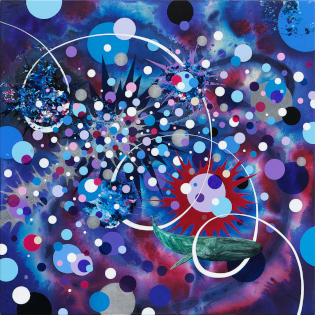
Kara Maria, née Kara Maria Sloat, is a San Francisco-based visual artist known for paintings, works on paper and printmaking. Her vivid, multi-layered paintings have been described as collages or mash-ups of contemporary art vocabularies, fusing a wide range of abstract mark-making with Pop art strategies of realism, comic-book forms, and appropriation. Her work outwardly conveys a sense of playfulness and humor that gives way to explicit or subtle examinations—sometimes described as "cheerfully apocalyptic"—of issues including ecological collapse, diminishing biodiversity, military violence and the sexual exploitation of women. In a 2021 review, Squarecylinder critic Jaimie Baron wrote, "Maria’s paintings must be read as satires [that] recognize the absurdities of our era … These pretty, playful paintings are indictments, epitaphs-to-be."

Edna Andrade was an American abstract artist. She was an early Op Artist.
Sarah Cain is an American contemporary artist.
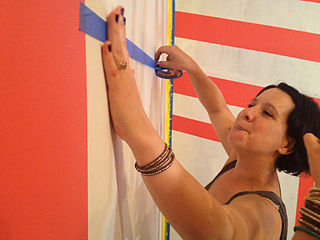
Clare E. Rojas, also known by stage name Peggy Honeywell, is an American multidisciplinary artist. She is part of the Mission School. Rojas is "known for creating powerful folk-art-inspired tableaus that tackle traditional gender roles." She works in a variety of media, including painting, installations, video, street art, and children's books. Rojas is lives in the San Francisco Bay Area.
Val Britton is an American artist, best known for her works on paper and installations. She creates abstract collage works using paper and other mixed media that reference the language of maps, network diagrams and astronomical photography. She lived in the San Francisco Bay Area for 14 years, and as of 2018, she lives in Seattle, Washington.
David Simpson is an American abstract painter who lives and works in Berkeley, California. In 1956 Simpson graduated from the California School of Fine Arts with a BFA; and in 1958 he earned an MFA, from the San Francisco State College. Since 1958 Simpson has had more than 70 solo exhibitions of his paintings in galleries and museums worldwide. His paintings have been included in hundreds of group exhibitions throughout the United States and Europe. During the early 1960s Simpson was included in two seminal group exhibitions: Americans 1963 at the Museum of Modern Art in New York curated by Dorothy Canning Miller and Post-Painterly Abstraction curated by Clement Greenberg in 1964; that traveled to the Los Angeles County Museum of Art the Walker Art Center and the Art Gallery of Toronto.

The Institute of Contemporary Art San José (ICA) is a nonprofit art center and gallery founded in 1980, and located in the SoFA District of Downtown San Jose, California, U.S. It supports contemporary artists working in painting, printmaking, sculpture, photography, new media works and site-specific installations. ICA San José is member and community supported. The art center offers rotating art exhibitions with free admission, along with public programs, education programs, and community events.
Ruth Laskey is an American artist known for her Minimalist weavings and grid paintings.
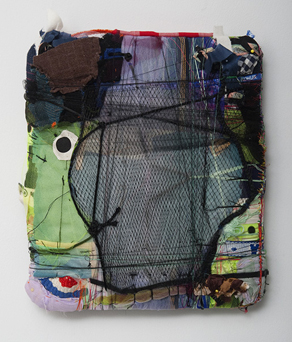
Julia Couzens is a California-based, American artist known for a diverse body of work that embraces unconventional materials and methods and includes drawing, sculpture, installation art, and writing. Critic David Roth identifies as a connecting thread in her evolving work, her "decidedly surrealist-symbolist sensibility, in which eroticism, the grotesque and the gothic mix in equal parts." Her work has been shown internationally and throughout the United States, including solo exhibitions at the Christopher Grimes Gallery and California State University, Stanislaus (2009), in surveys at the University of California, Davis and Sonoma Museum of Visual Art (1999), and group shows at the Crocker Art Museum, P•P•O•W, Orange County Museum of Art, Hammer Museum, and BAMPFA, among others. Her art has been reviewed in the Los Angeles Times, San Francisco Chronicle, Flash Art, New Art Examiner, and Art Practical, among other publications, and collected by institutions including the Crocker Art Museum, Fine Arts Museums of San Francisco, Oakland Museum of California and Butler Institute of American Art, among many. In addition to working as an artist, Couzens has taught at several Southern California universities and writes about contemporary art for The Sacramento Bee and Squarecylinder. She lives and works on Merritt Island in the Sacramento River delta community of Clarksburg and maintains a studio in downtown Los Angeles.
Ramekon O'Arwisters is an African-American artist, best known for his fabric and social-art practice, Crochet Jam. He creates art using the folk-art tradition of rag-rug weaving. Ramekon's work has been exhibited in New York, North Carolina, Tokyo, Bologna, Miami Beach, and San Francisco. He is also the former curator of fine-art photography at SFO Museum.
Jessica Snow is an American abstract artist, curator, and professor. Her paintings and drawings are distinguished by bright, vivid colors through a visual language that employs color, shape and texture to speak in conversation with the traditions of geometric abstraction, biomorphism, and color field painting. Her inspiration is fed by research into mid-century architecture, landscape design, 20th century art history and Asian art history. She lives and works in San Francisco, California, where she teaches painting, drawing and art appreciation at the University of San Francisco. Recently she researched Classical Chinese Gardens in Jiangsu province, and her recent ‘Master of the Nets’ series is based on this research.
Jackie Saccoccio was an American abstract painter. Her works, considered examples of gestural abstraction, featured bright color, large canvases, and deliberately introduced randomness.

Susan Landauer (1958–2020) was an American art historian, author, and curator of modern and contemporary art based in California. She worked for three decades, both independently and as chief curator of the San Jose Museum of Art (SJMA) and co-founder of the San Francisco Center for the Book. Landauer was known for championing movements and idioms of California art, overlooked artists of the past, women artists, and artists of color. She organized exhibitions that gained national attention; among the best known are: "The San Francisco School of Abstract Expressionism", "Visual Politics: The Art of Engagement", and retrospectives of Elmer Bischoff, Roy De Forest, and Franklin Williams. Her work was recognized with awards and grants from the International Association of Art Critics, National Endowment for the Arts and Henry Luce Foundation, among others. Critics, including Roberta Smith and Christopher Knight, praised her scholarship on San Francisco Abstract Expressionism, De Forest, Richard Diebenkorn, and Bernice Bing, among others, as pioneering. In 2021, Art in America editor and curator Michael Duncan said that "no other scholar has contributed as much to the study of California art." Landauer died of lung cancer at age 62 in Oakland on December 19, 2020.
Emiko Nakano (1925–1990) was an American abstract expressionist painter, printmaker, fiber artist, and fashion Illustrator.
Caroline Kent is an American visual artist based in Chicago, best known for her large scale abstract painting works that explore the interplay between language and translation. Inspired by her own personal experiences and her cultural heritage, Kent creates paintings that explore the power and limitations of communication. Her work, influenced by her Mexican heritage, delves into the potentials and confines of language and reconsiders the modernist canon of abstraction. She likens her composition process to choreography, revealing an interconnectedness between language, abstraction, and painting. Kent's artwork showcases an evolving dialogue of space, matter, and time, resulting in a confluence of drawings, paintings, sculpture, and performance, blurring the lines between these mediums.
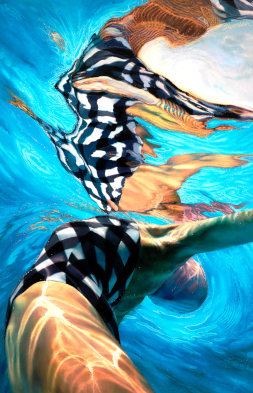
Lorraine Shemesh is an American artist whose practice focuses on painting, drawing, and ceramics. Since the early 1990s, she has created investigations of the human form that balance contemporary realism with an abstract expressionist concern for gesture, rhythm and pattern. Her best-known series depict active swimmers in pools viewed from above and underwater or intertwined, costumed dancers set in ambiguous, compressed spaces. In the 2000s, her work has increasingly moved towards abstraction, with figures dissolving into faithfully rendered optical phenomena or geometric patterning. Describing these qualities, Art in America critic Jonathan Goodman wrote, "being true to nature enables Shemesh to record a dazzling array of painterly gestures, some of them squarely within the tradition of Abstract Expressionism … Her use of abstract effects in the service of representation is striking and makes her art complex."
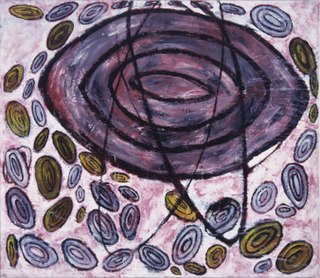
Joan Moment is an American painter based in Northern California. She emerged out of the 1960s Northern California Funk art movement and gained attention when the Whitney Museum of American Art Curator Marcia Tucker selected her for the 1973 Biennial and for a solo exhibition at the Whitney in 1974. Moment is known for process-oriented paintings that employ non-traditional materials and techniques evoking vital energies conveyed through archetypal iconography. Though briefly aligned with Funk—which was often defined by ribald humor and irreverence toward art-world pretensions—her work diverged by the mid-1970s, fusing abstraction and figuration in paintings that writers compared to prehistoric and tribal art. Critic Victoria Dalkey wrote that Moment's methods combined chance and improvisation to address "forces embodied in a universe too large for us to comprehend, as well as the … fragility and transience of the material world."
References
- ↑ "Amy Ellingson". Artland. Retrieved 16 June 2021.
- ↑ Roth, David M. (January 17, 2012). "One Thing Leads to Another @ ICA". Square Cylinder. Retrieved September 24, 2021.
- ↑ Crowther, Paul (2018). Geneses of Postmodern Art: Technology as Iconology. New York and London: Routledge. pp. 146–147. ISBN 9781138605749.
- ↑ Ellinson, Amy. "Amy Ellingson". artist's website. Retrieved October 1, 2021.
- ↑ "An Evening with Artist Amy Ellingson". Start Up Art Fair blog. 20 September 2019.
- ↑ "Amy Ellingson | Root Division". rootdivision.org. Retrieved 2016-06-16.
- ↑ "Amy Ellingson Gallery Talk" . Retrieved September 24, 2021.
- ↑ Roth, David M. (September 22, 2016). "Chopping Wood on the Astral Plane". Square Cylinder. Retrieved October 21, 2021.
- ↑ The Iconology of Abstraction: Non-figurative Images and the Modern World. Routledge. 2020. pp. Section 7.2. ISBN 9780429557576.
- ↑ Roth, David M. (August 1, 2014). "Amy Ellingson @ SJICA". Square Cylinder. Retrieved October 21, 2021.
- ↑ Morris, Barbara (November 28, 2017). "About Abstraction @ Bedford". Square Cylinder. Retrieved October 21, 2021.
- ↑ Roth, David M. (October 5, 2015). "Jay DeFeo @ Hosfelt". Square Cylinder. Retrieved October 21, 2021.
- ↑ Crowther, Paul (2019). Geneses of Postmodern Art: Technology As Iconology. Routledge. pp. 146–147. ISBN 9781138605749.
- ↑ Robinson, Megan D. (May 29, 2018). "Amy Ellingson's Abstractions for a Virtual World at Robischon Gallery". Art & Object. Retrieved October 21, 2021.
- ↑ Kee, Christina (July 28, 2011). "Driven to Abstraction, A Group Show at Von Lintel Gallery". Art Critical.
- ↑ Whiting, Sam (13 December 2015). "Art installations soothe delays at SFO". SFGate. Retrieved 28 August 2016.
- ↑ "Public Art Collection". flysfo.com. Archived from the original on 2016-04-21. Retrieved 2016-06-16.
- ↑ "ICA San Jose: Amy Ellingson, Iterations and Assertions". ICA San Jose. 11 December 2019. Retrieved Oct 4, 2021.
- ↑ Interview with the artist. https://www.eliridgway.com/news/of-a-piece-amy-ellingson-variation-apparent-reflectional-symmetry
- ↑ "Exhibitions: Open Ended, Painting and Sculpture, 1900 to Now". SFMOMA.
- ↑ "Unfamiliar Again: Contemporary Women Abstractionists". Newcomb Art Museum of Tulane. Retrieved October 1, 2021.
- ↑ "The Fleishhacker Foundation | 2008-2010". fleishhackerfoundation.org. Retrieved 2016-06-16.[ permanent dead link ]
- ↑ "Past Awardees - Artadia". Artadia. 2 May 2013. Retrieved 2016-06-16.
- ↑ "The MacDowell Colony". macdowellcolony.org. Archived from the original on 2009-05-26. Retrieved 2016-06-16.
- ↑ "Ucross Foundation :: Visual Arts". ucrossfoundation.org. Archived from the original on 2015-06-11. Retrieved 2016-06-16.
- ↑ exhibit-e.com. "Amy Ellingson - Fellows - Civitella Ranieri". civitella.org. Archived from the original on 2016-04-06. Retrieved 2016-06-16.
- ↑ "About". Amy Ellingson. Retrieved 2016-06-16.